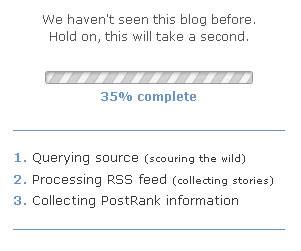Back in January Amit Agarwal wrote a post called “How to Reduce RSS Stress In Your Online Life” in which he talked about managing enormous lists of RSS feeds. It’s likely that your feed list doesn’t top 1200 like Amit’s, but even with just 20 or 30 feeds, the constant stream of news can get overwhelming. At the time, on my own blog, I advised people to simply read fewer feeds, but now a team from Ontario, Canada led by programmer Ilya Grigorik thinks they have a better solution: AideRSS.

AideRSS, which launches today, is a new type of RSS filtering service that uses a proprietary system called PostRank to determine the best posts on each blog. I first read about PostRank on Ilya’s blog last December and remember being very intrigued and thinking, “There’s a web service in this.” Just over 6 months later, Ilya’s idea is being born as AideRSS, which I have been playing around with for a little over a week.
What is PostRank
6 and a half months ago when Ilya conceived of PostRank, he described it this way:
“I look at the number of comments, number of bookmarks the visitors made, and the number of trackbacks. I collect this information from the internet and then normalize each post against the average for the blog in question – if you always get 15 comments, then you getting 17 comments doesnÄôt affect the ranking as much as, say getting 15 comments when you usually get 2.”
PostRank still works more or less the same way, but it now includes information from digg, del.icio.us, Technorati, IceRocket and Bloglines. PostRank ranks post from 1-10 (with 10 being the most important posts), and the idea is that the most talked about posts are likely the most important. The key to making PR work, however, is really the normalization. A PR10 post on Slashdot, for example, where 100 comments isn’t out of the ordinary, will be different than a PR10 post on a smaller blog where 15 comments might be abnormal.

“Trying to define ‘good’ for every blog is impossible,” Ilya told me, which is why PostRank is figured based on the average performance of each blog. “Otherwise, the ‘A-list’ will skew all the scores,” says Ilya, who built AideRSS using Ruby (back end) and Rails (front end). The site utilizes Amazon’s Elastic Compute Cloud service in order to keep the growing index of sites up to date.
I did notice one weakness in AideRSS rankings, which which was a result of the service relying on outside services. The specific example that I saw involved my rarely updated personal blog, which had one post defined as a PR10. The problem was that it seemed to have achieved that ranking because of a bunch of trackback spam that Technorati let slip through. In this case, Technorati’s failing adversely affected AideRSS rankings. Hopefully the guys at AideRSS can figure out a way to apply their own spam and trackback filters to make sure posts are not ranked highly because of spam comments or bad links that slip by other services.
How Do You Use AideRSS
AideRSS couldn’t be simpler to use. Enter the URL of a website, and the application automatically finds and analyzes the feed if it hasn’t seen it before. Once that is completed, the service displays a page with that site’s last 20 posts. The posts can be organized by date or PostRank. Clicking on the ‘More’ button shows a brief excerpt from the post, as well as information on the various PostRank elements. Clicking on the title of each post will direct you to the post itself.

Posts can be filtered into three categories: good, great, and bests posts. This is again normalized to each blog. For example, since July 2nd, 21% of Read/WriteWeb’s posts have been deemed by AideRSS to be in the “best” category, each having a PR between 6.5 and 10. For Slashdot, however since July 5th only 3% have achieved “best” status, with the highest PR among them at 8. It’s important to note that because PostRank is normalized for each blog, a PR8 post on Slashdot is vastly different than a PR8 post on Read/WriteWeb.
Users can subscribe to filtered feeds (either good, great, or best posts feeds) via RSS in their usual feed reader, or add filtered feeds to their ‘My Feeds’ page. The My Feeds dashboard shows a mashup feed that includes every filtered feed the you’re tracking. You can subscribe to that mashup feed in your normal feed reader.
In addition to adding feeds by hand, users can also import an OMPL file into AideRSS. Or if you decide you want to bring your saved feeds to another RSS reader, you can export an OPML file as well.

AideRSS For Bloggers
AideRSS is free and intends to remain that way. Their FAQ promises that there will always be a free version of the service available. I asked Ilya what his plans for monetizing the service were, and though he said the main focus right now is building the free consumer service, he hinted at the possibility of publisher services. Ilya told me that as the index grows, there exists the potential for meaningful analysis of post and reader trends, patterns, habits, meme tracking, etc. These sort of services are the type of things that could potentially be offered on a for-pay basis to publishers, but Ilya stressed that that is not a focus for AideRSS at the moment.
The website does offer a couple of blogger-centric services, however. The “Sharing & widgets” page for every site indexed by AideRSS offers two services aimed at publishers: a syndication widget that provides RSS links to AideRSS-filtered feeds (good, great, and best) as well as a top posts widget that lists the top ranked posts over a given time period. Below is Read/WriteWeb’s best posts over the past month according to AideRSS. These are the posts that elicited the largest response from our readers, and according to the AideRSS system are thus deemed the most likely to be our best.
Top Posts: Read/WriteWeb
Conclusion
When I first read about Ilya’s idea for a PostRank system, I was impressed. The service he and his partners Francis Lau and Kevin Thomason have put together is equally impressive. AideRSS is a novel way to filter RSS feeds that I think could be truly useful. More importantly, though, I think the real value of this service will come in the future, when and if they develop publisher tools that allow bloggers to track reader behavior. AideRSS should be able to theoretically help bloggers find that holy grail of blogging: the key to posts that your readers consistently respond to. Give AideRSS a try and let us know in the comments what you think about the service.




















